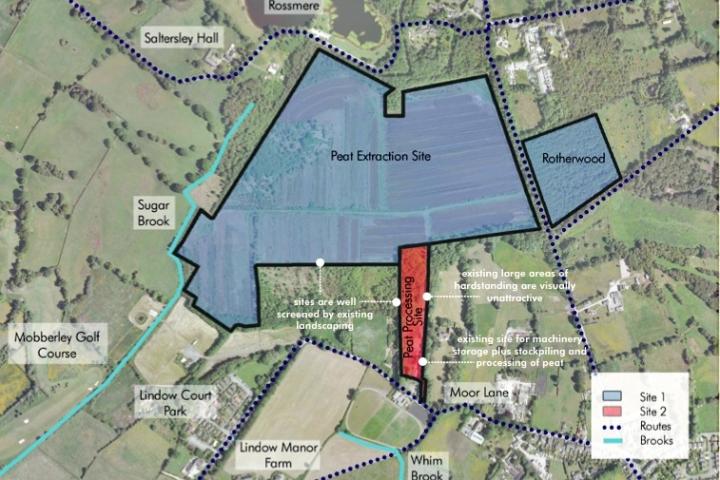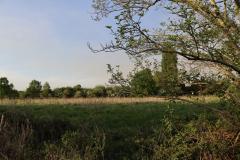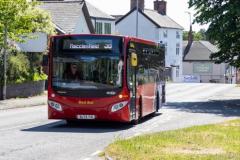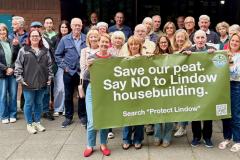
Plans to build 14 detached houses on part of Lindow Moss and restore the 28 hectares peat extraction site to a natural wetland habitat are set to be determined by the Strategic Planning Board next week.
The proposal concerns two planning applications. The first application, reference 15/0064M, is for the 28 hectare peat extraction site and the second application,15/0016M, relates to an area of 1.763 hectares to the south of the peat bog, both of which lie within the Green Belt.
The owners of the land Andrew Rowland and Richard Bond are proposing that peat extraction ceases once planning permission for the houses is granted and Lindow Moss is restored as a matrix of peatland wetland habitats by encouraging the return of native flora and fauna and enhancing the range of habitats which already exist.
The processing area will be replaced with a development of 14 detached family homes.
Planning permission for peat extraction on Lindow Moss was granted by five separate permissions between 1959 and 1967, which expire in February 2042.
The Planning Officer is recommending that both planning applications are approved by members of the Strategic Planning Committee at their meeting on Wednesday, 19th December because, whilst the proposal is deemed an inappropriate form of development in the Green Belt, factors in favour of the development are considered to outweigh the identified harm.
The Planning Officer concluded that "The proposal is an inappropriate form of development in the Green Belt, which reduces openness and conflicts with the purposes of Green Belt through encroachment. There is also harm arising from the loss of trees and woodland on the site, the impact on highway safety, the absence of any significant variation in house types and the design and layout of the proposal not being in keeping with the established character of the area.
"The factors in favour of the development, including some provision of affordable housing and the very significant ecological benefits arising from the early restoration of the adjacent Lindow Moss, are, on balance, considered to clearly outweigh the identified harm, to amount to the very special circumstances required to justify the development in the Green Belt."
The officer added "Under normal circumstances, this is not a development proposal that would be supported by officers. However, the stated benefits have the potential to be nationally significant, or even of "European Importance." Therefore, on balance, it is considered that the significance of the benefits does outweigh the identified cumulative harm in this case."










Comments
Here's what readers have had to say so far. Why not add your thoughts below.
If this development is going to be approved, could it be conditional upon the wetland restoration being fully completed BEFORE any housing development is allowed to commence?
I'm not sure I'd buy a house on a peat bog! (or nearby).
More open space around Wilmslow to disappear.
Croghan Peat have ignored, indeed destroyed, the delicate flora and fauna of the Moss. Cheshire East have not enforced conditions imposed on the latter company. Neither should be trusted in this matter.
The article leader reads like a hopeless official (is this the outsourced 'Planning Officer' by any chance) using a thin veneer of excuses - err, apologies - as justifiable reasons to allow the application rather than enforce (that's a laugh) restitution of an otherwise recognised site of special interest that has been unashamadly raped and deliberately spoiled over many years.
CEC in this instance abrogated any moral, civic and professional responsibilities they clearly own, and owe, the community - It's real Greenbelt or special historical and natural ecological interest.
I haven't closely followed the long running issues surrounding the peat workings on Lindow Moss but my use of the kennels thereon gives me some insight into the misery and worry brought down on the residents.
Apart from the abuse dealt out by dubious industrialists with vested interest to wring out every financial advantage they can from their asset, it's an utterly disgraceful way to treat long term residents.
CEC cohorts are just going along the same disinterested path they choose to follow for their own ends - Kick em out big time next year otherwise it will never end.
A travellers planning application on Moor-lane has already been rejected for this very reason several times so why should this even be considered
I also heard that there is a possibility of further plans for more houses to be built around the Moor Lane and Leigh Road area, a possible 500! If this is so can you imagine the amount of extra traffic this will bring to this part of the countryside,.
An average home these days has 2 cars, another 1000 cars is a possibility, just doesn't bear thinking about does it?
F.Maltby
The restoration of this precious historic wetland needs addressing through secured funding not through a fantasy project which history tells us will not happen.
Totally agree with all previous posts above.
Maybe it’s because our councillor Gary Barton doesn’t do anything for the neighbourhood. He needs to get more involved.
As Roger states, the site should be protected for the historic significance. It’s amazing they have got away with it all these years, and the poor people that are suffering the subsidence in that area. CEC really needs to improve.
If not, then... the number of nil-responses continues to grow.
But the more I read the proposal, the more it seemed like blackmail or a bribe and I don’t believe this is how the planning system is meant to work.
In section 6.5.6 of the Supporting Statement the applicants state quite blatantly that if the application is approved then they will cease extracting peat and restore the site to a high quality nature reserve. If not, then they will continue to extract peat to 2042 with all the adverse effects on the local landscape, the local residents and the local highway network.
In other words, give us planning permission or else!
Should the council be mislead by fine words such as "restored as a matrix of peatland wetland habitats" and "encouraging the return of native flora and fauna" they should consider who exactly is going to do this once planning permission for 14 homes has been granted. What exactly is there to stop Crogham Peat Industries going into voluntary liquidation about 30 seconds after planning permission has been granted. And walking away with a fine profit from the sale of building land. AND walking away from any responsibility to restore the peat bog.
In any event, the site is in Green Belt and there are no very special reasons why the green belt should be infringed.
I am opposed to this application and sincerely hope the council and planners do not fall for it.
Richard Stain
Last year, damaged peatlands in the UK discharged more than 10 million tonnes of CO2 which effectively negated the 12 million tonnes of CO2 emissions saving in the national
economy (IUCN National Committee for the UK). Lindow Moss is a severely damaged peatland but if restored, could be an effective carbon sink, and make a very significant contribution to reducing CO2 emissions. Without restoration, it will continue to discharge CO2.
It is almost 4 years since these planning applications were first submitted and during this time water has continued to drain from the Moss in an uncontrolled manner, with concomitant drying and oxidation of the peat, culminating in a major peat fire in June of this year. There is an urgent need to re-establish water levels and initiate peatland restoration before this becomes impossible to achieve. It is vital that restoration begins IMMEDIATELY.
We know from the popularity of our guided walks for adults and children on Lindow Moss, our Lindow Moss workshop and Guild Day School in 2014 and many meetings since, how much people in Wilmslow value the Moss. Many of the comments submitted to the Wilmslow Neighbourhood Plan commented on the importance of the historical, archeological and ecological aspects of this very special place, and Lindow Moss has now been recognised as a Heritage Asset in the draft NP. It is also a place where people love to walk.
There is no proposal that we know of that could restore the Moss without the housing application. If the two applications are approved, then approval of 15/0064M will rescind existing planning conditions including the disastrous outcome of backfill with inert waste and "restoration" to agriculture.
We know that many people will be very concerned about the housing application, and with good reason. It is vitally important that CEC apply planning conditions and monitor them properly to ensure that the Moss is properly restored. We support the applications on the basis that there must be robust governance of the restoration. We propose an expert and properly constituted Moss Restoration Committee (including experts in the ecology, archeology and history of the Moss) who report to a Community Oversight Committee where everyone concerned for the Moss can contribute to the proper governance of the Moss. There must be a Lindow Moss champion in CEC who is prepared to respond to concerns of local people; there has been a lack of communication between CEC and members of the public about the Moss in the past, which has contributed to a sense of lack of trust. We ask that if planning is agreed, the Restoration Committee and Community Oversight Committee are established as soon as possible (ideally next month) so that all the stakeholders (community groups, local people, WTC) can contribute to the restoration plans and ensure that this cherished local asset is restored.
Lindow Moss is a cultural as well as an ecological landscape, and the restoration needs to reflect this. It should include recognition of the historical heritage including the Lindow Man findspot and the Crimean rifle range, its industrial heritage (the history of peat working and the Moss Rooms) and its landscape setting (the woodland fringes provide the enclosure which is so important to its "sense of place"). A scheme which properly recognises the Moss's cultural importance over millennia will benefit tourism and education, as well as recreation and exercise.
Transition Wilmslow would normally resist any development in the green belt and will continue to resist very strongly any development which intrudes into the Lindow Moss landscape.
In the absence of any other proposal to restore the Moss we see the approval of these linked applications as the only way to prevent the complete disaster that would be continued peat cutting until 2042 followed by landfill. However there must be really robust mechanisms in place to ensure that local people and independent experts are able to ensure that the restoration plans are properly followed through and the many valid concerns of Wilmslow residents are properly addressed.
Pippa, I agree with you 100% in wishing to see the peat bog restored - nobody could be more committed to this than me.
But given the history of continual failed enforcement by Cheshire County and the obvious disregard that the Crogham Peat owners have for the moss, how can you possibly bring yourself to believe that any form of restoration of the moss would happen. Once they have planning permission they will be gone. Just wait and see how quickly Crogham Peat will be wound up. And once Crogham Peat are gone, who will restore the moss? Well who?
This is blackmail, pure and simple, "give us planning or else we'll continue to rape the countryside"
If Cheshire East Council had the will to stop this they could find a way. They could start by enforcing the existing conditions and making it plain they will not give in to blackmail.
I most strongly object to this "deal" - it is not the business of the planners to be making deals and the land they are proposing to build on is Green Belt - once it's gone it's gone for ever.
Richard Stain
The Moss is one of the most significant peat landscapes in the UK and therefore both a regional and national heritage asset that deserves to be protected. After years of extraction it is however in a damaged condition requiring immediate attention.
The current proposal appears to be a “deal” which does not guarantee its long term future for the public good or satisfy the legitimate and valid concerns of many people. It also means giving up a large piece of green space for development.
It has been reported that some conditions placed on Croghan Peat in 2003 ( the main ones seem to be construction of a sluice gate and settling pond ) have not been implemented by them. If this is correct, and they have not been discharged, it follows that they remain as an obligation for them to meet. Surely this is the starting point of any “deal”.
I hope that the Strategic Planning Board will provide leadership on this matter next week and help its officers to urgently find a different solution.
Many apologies for repeating myself....... there should be a special clause in the planning consent stating that the full and thorough restoration of the Peat bogs MUST be completed by Croghan Peat BEFORE the development of houses commences. Otherwise building work cannot proceed!
First of all, the money generated from the permission will be a fraction of that needed for what could be a 10 year project just to stabilise the water table.
Secondly, the track record of both these organisations is not to be trusted. We are all aware of the contempt they have treated residents, certainly over the 20 years we have been involved. Don't forget, we were once told the 51 conditions would be 'rigorously enforced'.
For example, the court case in 2005 when Croghan pleaded guilty and were fined (then carried on as before). The Chief Enforcement Officer for CCC saying conditions are only enforced when expedient to do so, then deciding with Terraqueous (Croghans ecological advisor, related to the owner of Croghan and working from the same offices) that the sluice and settling pond were not needed.
Continued trashing so Derek Gow, foremost expert on water voles and water vole conservation in the UK was asked to conduct a survey in 2010 armed with the Water Vole Protection Scheme. His report showed that protected ditches and areas had gone and the site badly damaged. Reports given to CEC but no action takent
2012 saw a complaint to the Local Government Ombudsman. The conclusion found CEC guilty of 'maladministration' which 'must not be
allowed to continue'. No action from CEC.
Derek Gow returned in 2015 and stated that in all his experience he had never seen a site so comprehensively trashed. From water voles once being widespread on the site he only found concrete evidence in one ditch.
Then again in 2015 Croghan Peat breached the sand, again a contravention of a condition. This is at the north east corner of the site, nearest to Newgate
Kennels, and the subsidence to the kennels is common knowledge.
Now, after 20 years of trashing and being ignored, why are CEC suddenly saying the site is 'nationally significant' and of 'European Importance'. Who do these people think will believe them?
Pass the sick bag.
Thank you for enlightening me.
I’m afraid I don’t have a sick bucket large enough for your requirements!!!!
Is there any hope ?
After reading your post above, I fear not !!
Councillor Gary Barton has been aware of the problems on the moss for years and in particular how they have affected Newgate Kennels.
Help received? None!
Due to complete disregard for planning regulations and other peoples property, Croghan peat have already damaged many properties in the local area with their mass de-watering of the peat bog and I fail to see how the new development can be stabilised in the long term.
I'm very disappointed by the weak acquiescence by Transition Wilmslow, I would have expected more.
I don't have any real ideas on how to take this up a level, a first step would be to for CEC to mandate all outstanding legal obligations are fulfilled but I think that now that horse has bolted. Roll on May - though I fear not enough residents will even realise or care what is going on...